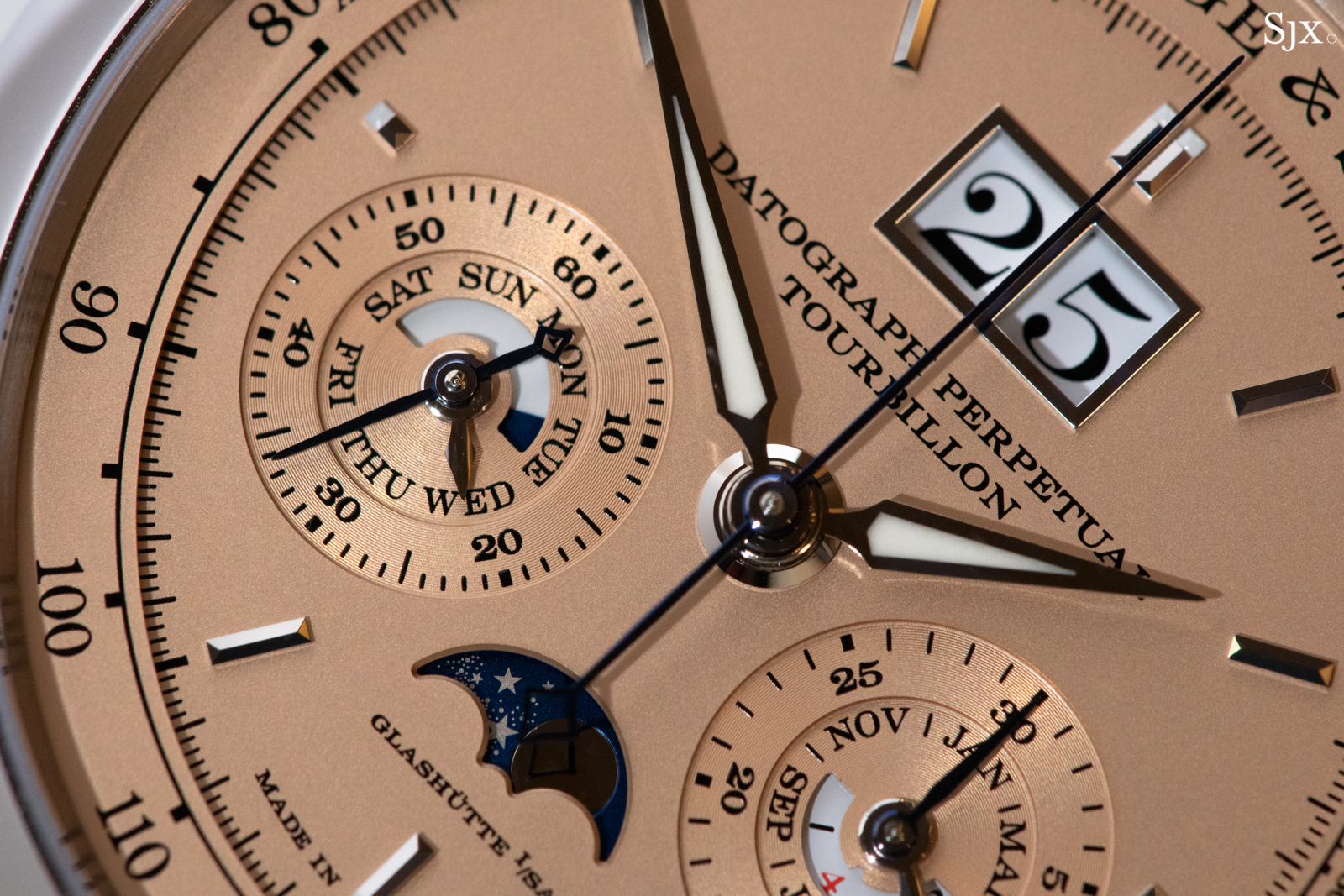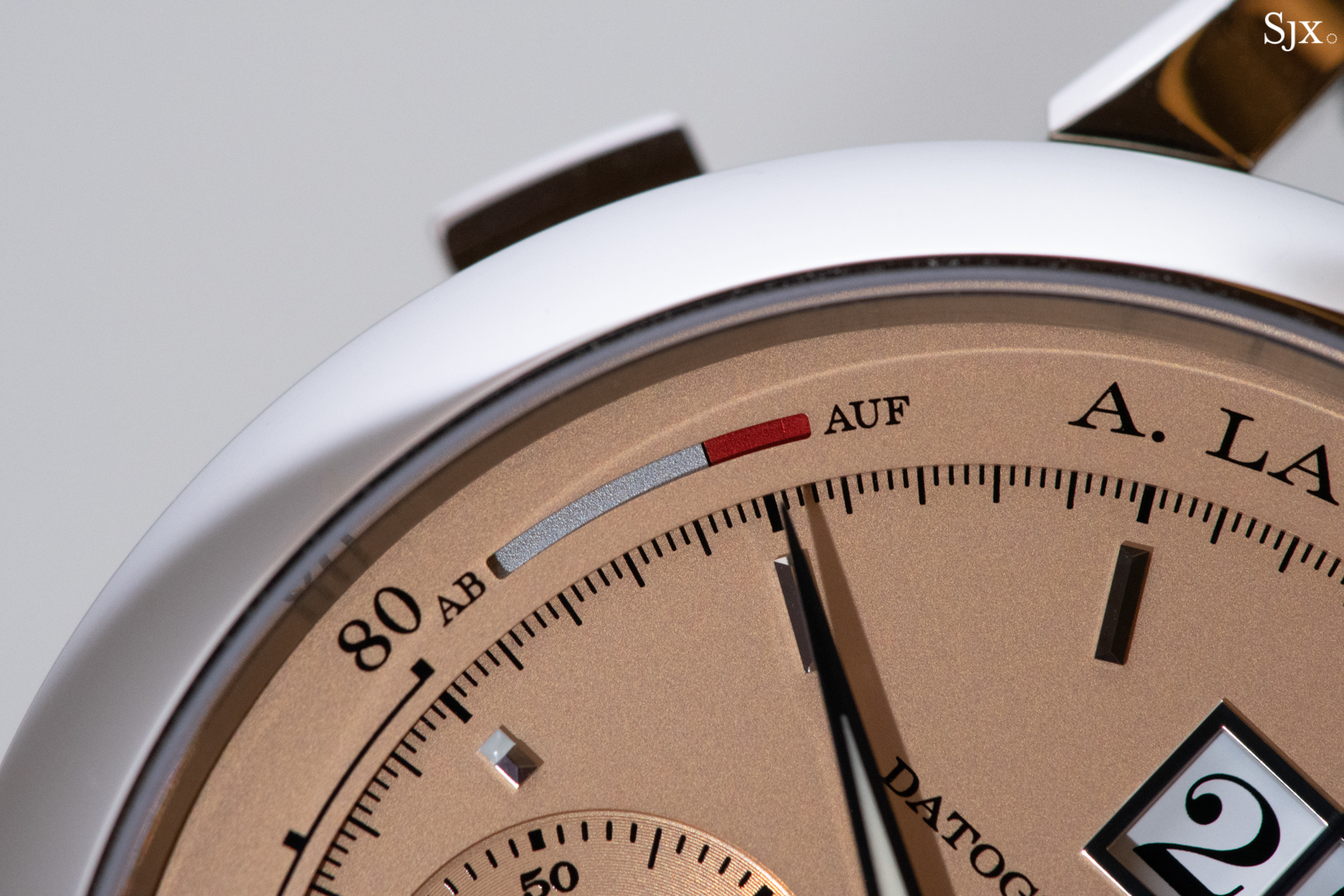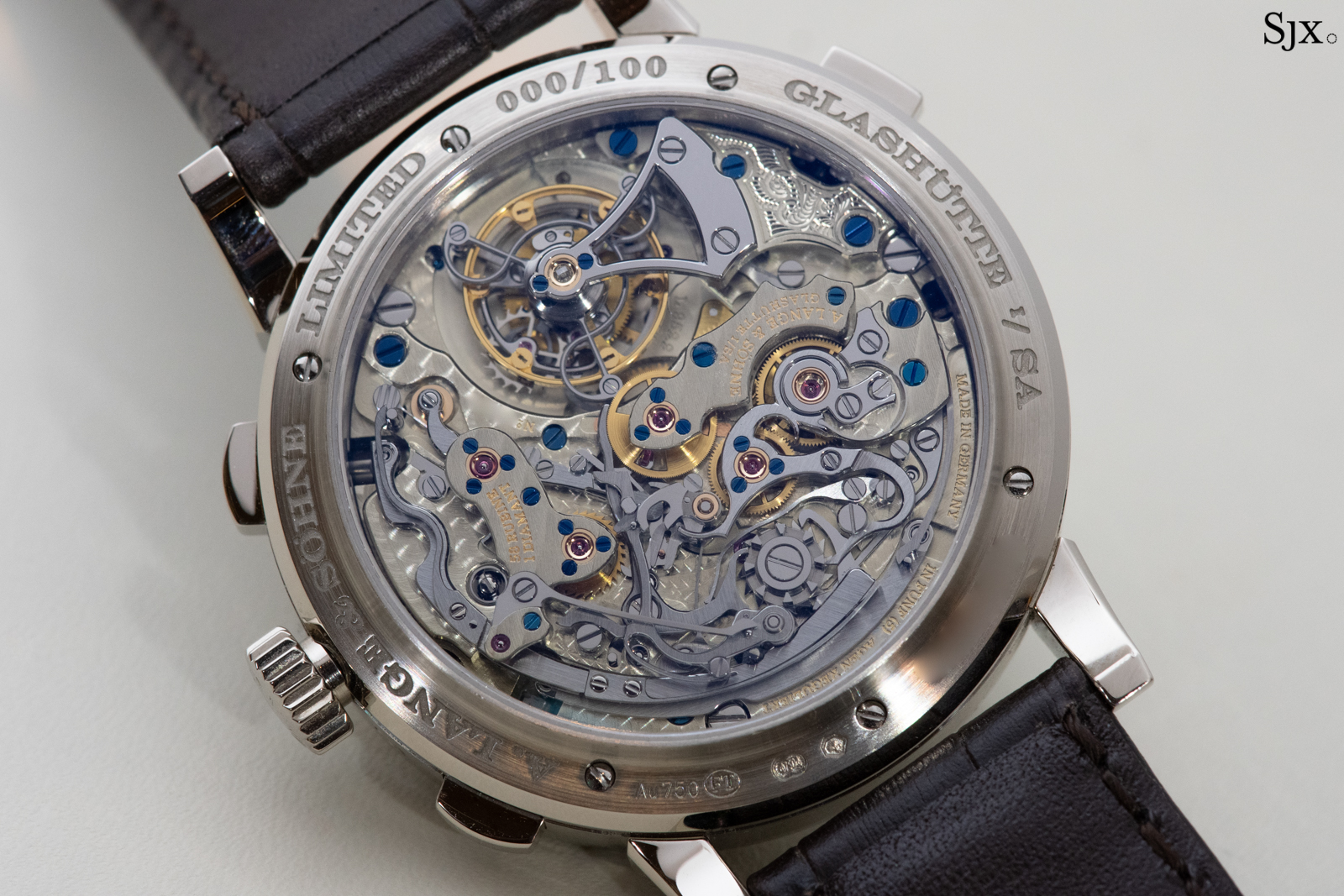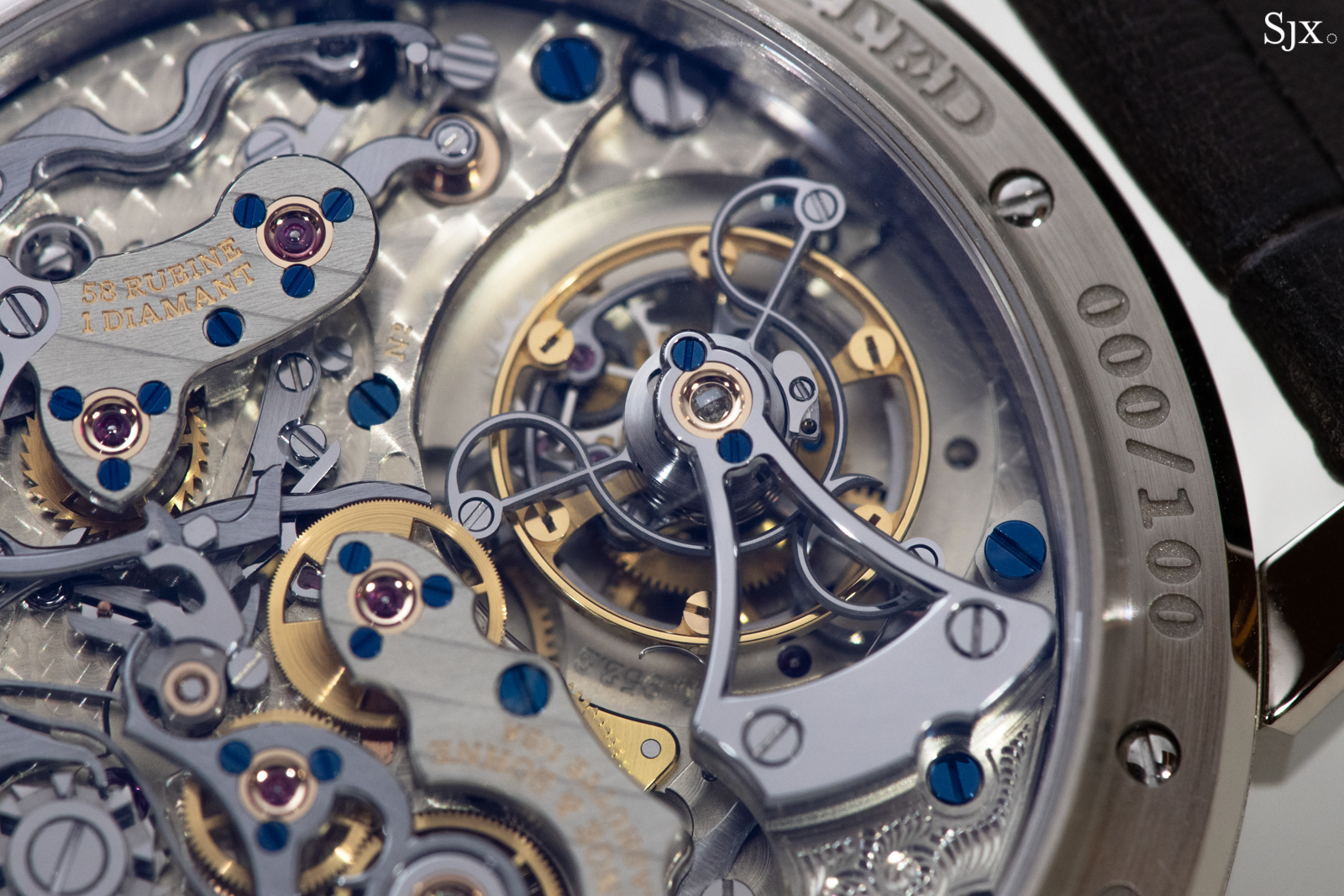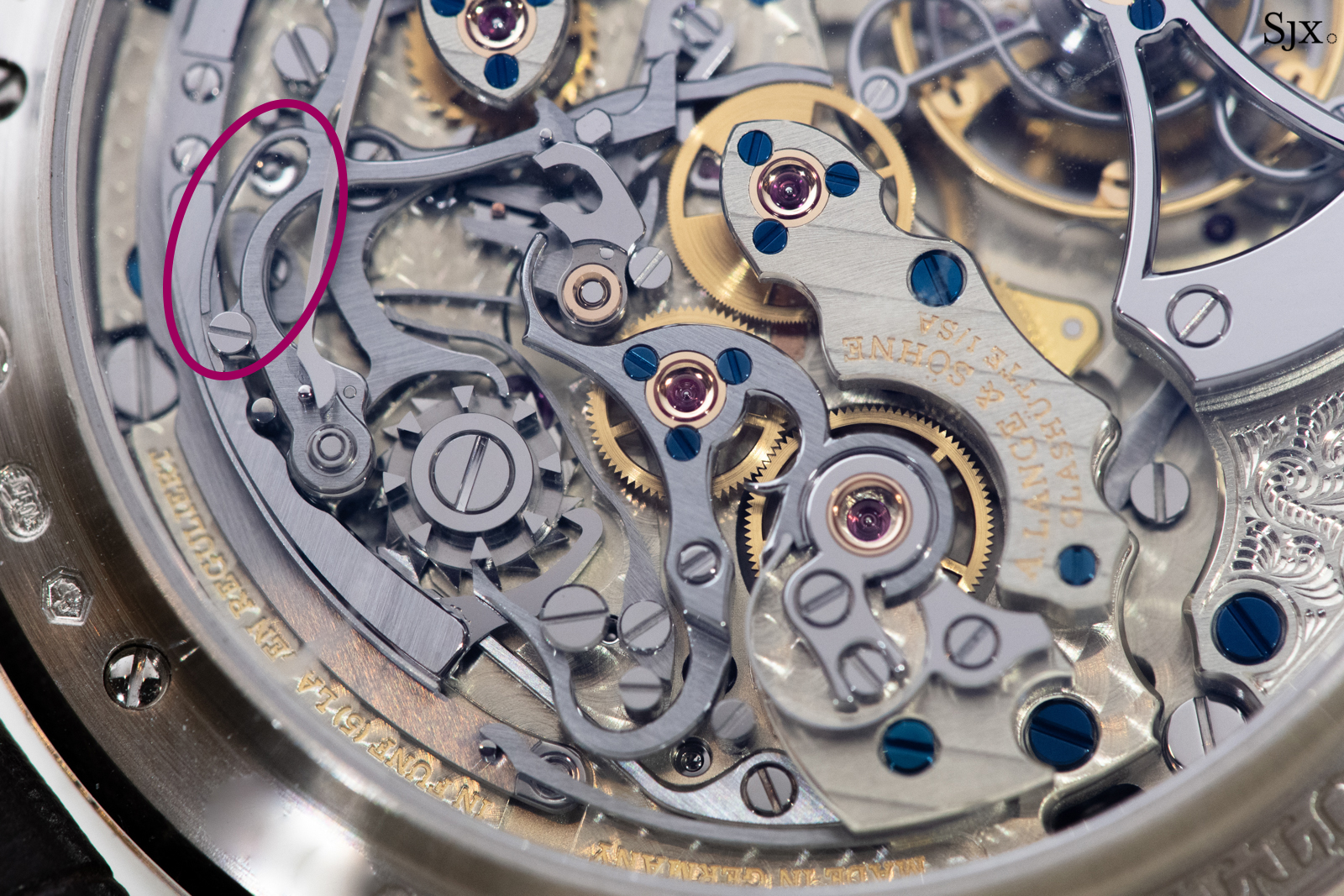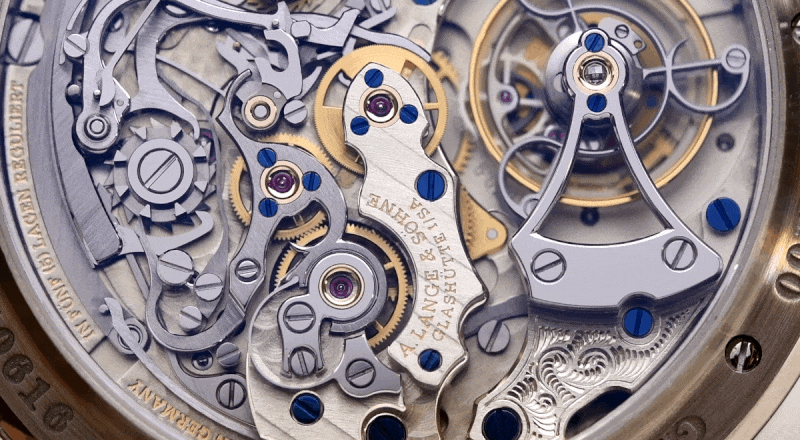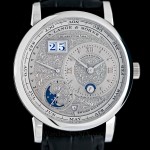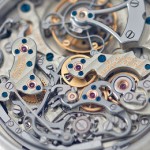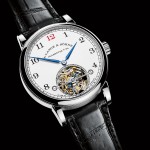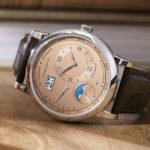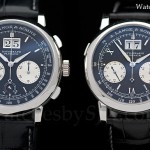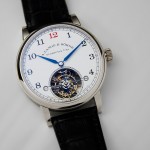In-Depth: A. Lange & Söhne Datograph Perpetual Tourbillon Pink Gold Dial
Revisiting the flagship chronograph in detail.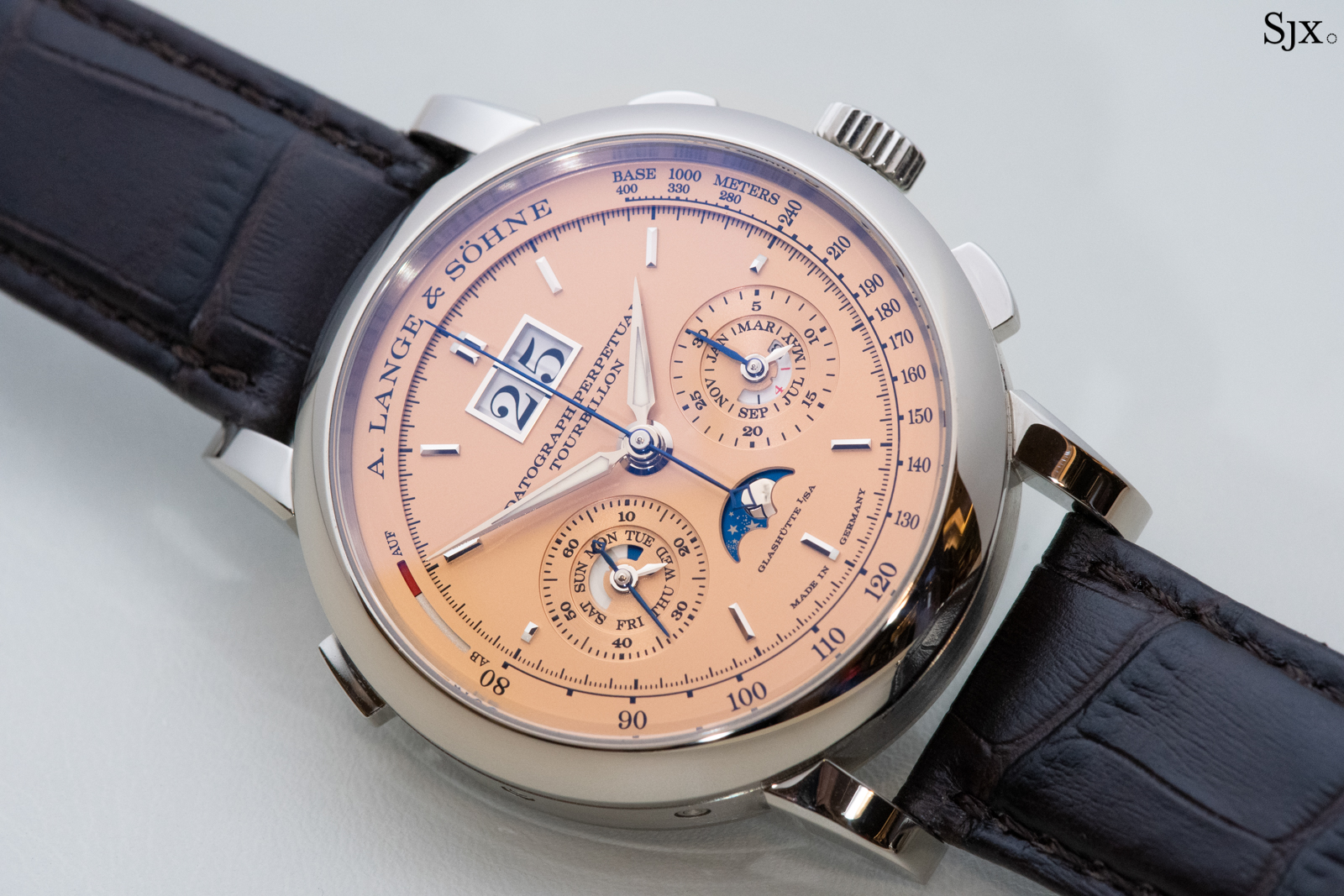
Earlier this year at SIHH 2019, Lange introduced a new variant of the ultimate chronograph, the Datograph Perpetual Tourbillon in white gold with a pink gold dial. This follows the original from three years ago, that was in a stark combination of platinum with a black dial.
When A. Lange & Söhne unveiled the Datograph in 1999, it was a statement to the world. The fact that the recently re-established Glashütte watchmaker was able to develop a new, high-end, in-house chronograph – something missing from rival brands’ catalogues – was a revelation for collectors and wake-up call for its competitors.
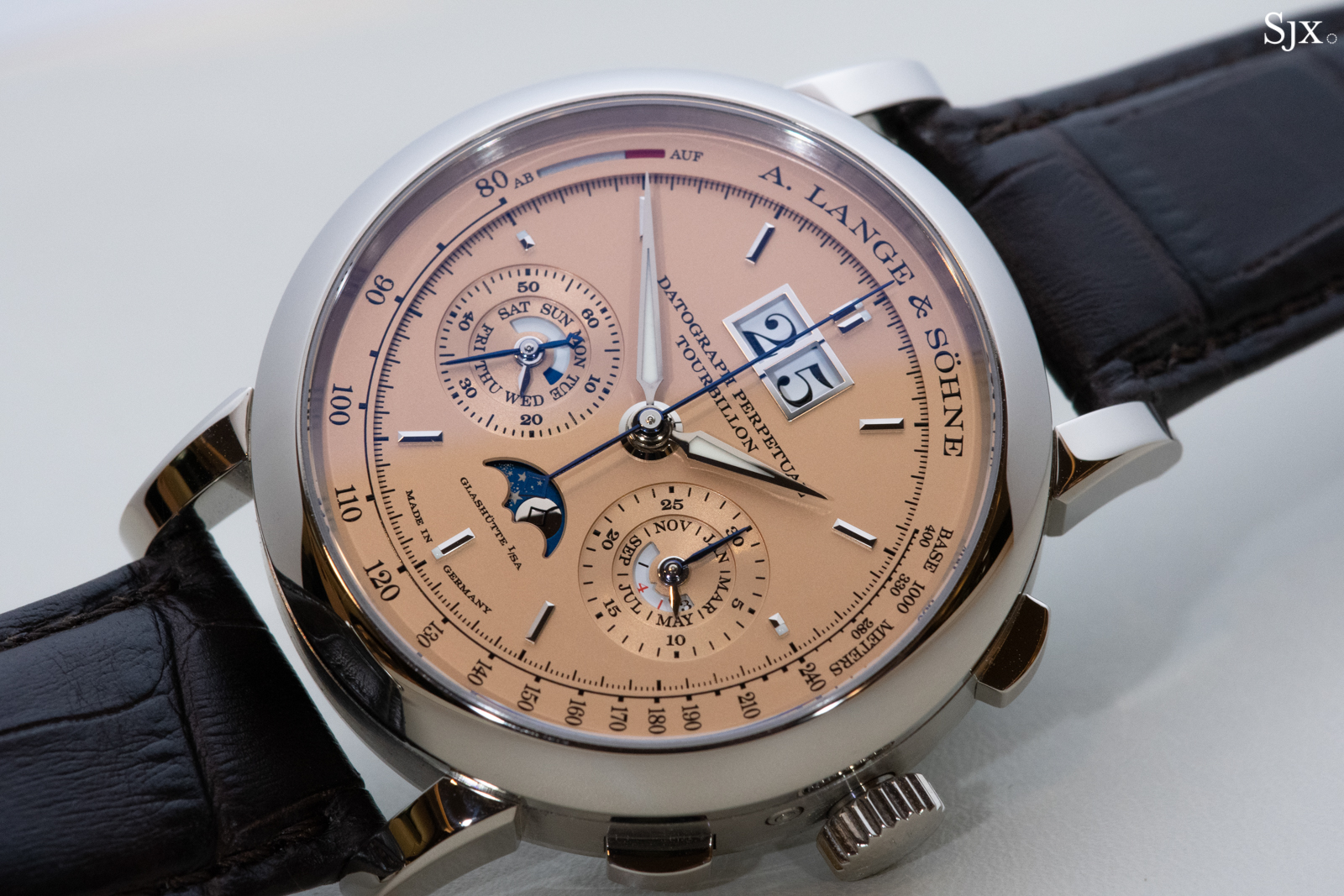
The Datograph movement, the cal. L951.1, was not technologically groundbreaking – the construction and styling was largely inspired by classical pocket watch movements – but its combination of high-end features and vastly distinctive aesthetics, particularly compared to its Swiss counterparts, left everyone else’s chronograph in the dust.
Even till today, Lange chronographs are still revered and firmly placed in the upper echelons of high horology. So was only natural that after the Datograph, the brand expanded the chronograph line-up, starting with a basic chronograph sans big date, to perpetual calendar chronographs, alongside the parallel collection of split-seconds that includes a double and even a triple rattrapante.

Fashionable “salmon”
The name explains it all: the Datograph Perpetual Tourbillon is a manually-wound chronograph combined with a perpetual calendar and tourbillon. Unlike most tourbillons regulators, this one is concealed and visible only from the back, though the prominent “tourbillon” on the dial is a giveaway.
Naturally, the novelty of this edition is the solid rose gold dial, more often known as a “salmon” dial. Given how fashionable “salmon” are dials today, particularly on vintage-inspired watches, it was perhaps a surprise that Lange, typically a serious-minded, monochromatic brand, chose to debut this dial colour on a flagship grand complication
The dial has a consistent matte finish throughout, which contrasts the fine concentric guilloche of the sub-dials – pretty much the standard dial finish for all Lange chronographs.
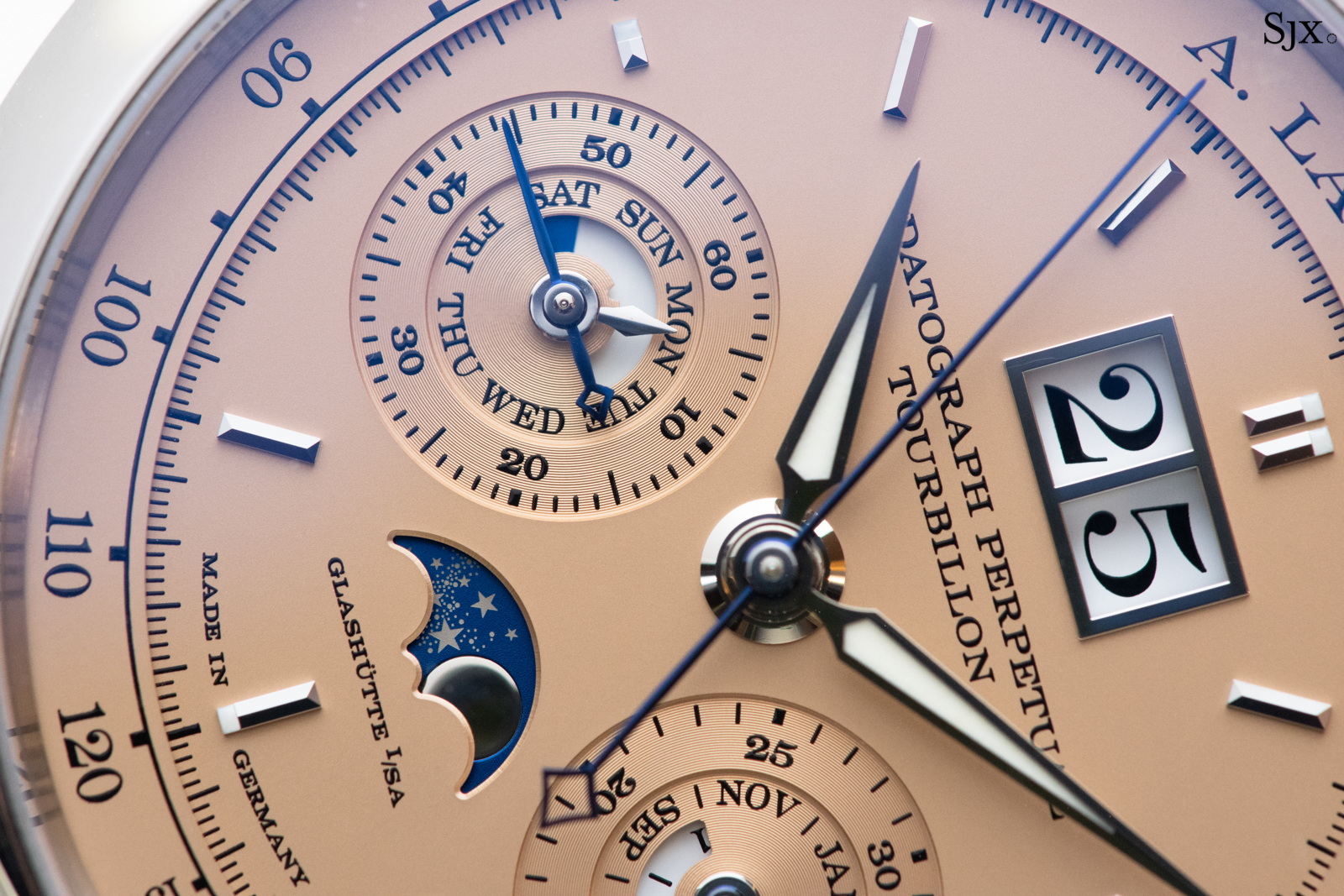
To distinguish them from the calendar pointers, the running seconds as well as chronograph seconds and minute hands are blued
Legible, somewhat
The sub-dials are densely packed with information, with the register at eight o’clock containing the running seconds, day of the week and day/night indicator.
Meanwhile, the sub-dial at four contains the chronograph minutes counter, month, and leap year indicator.
This layout is similar to that found on Datograph Perpetual, which relies on sub-sub-dials, or in other words smaller dials within the sub-dials, to display the information. In contrast, the day/night and leap year indicators here are shown via concentric discs visible through cutouts on the sub-dials, making the aesthetic neater and more legible.
One may argue the dial design is cluttered – classical perpetual calendars usually have three sub-dials to spread out the calendar information around the dial – but the layout is no doubt Lange’s attempt at preserving the classic Datograph dial with slightly sunken twin registers and the signature big date at 12 o’clock.
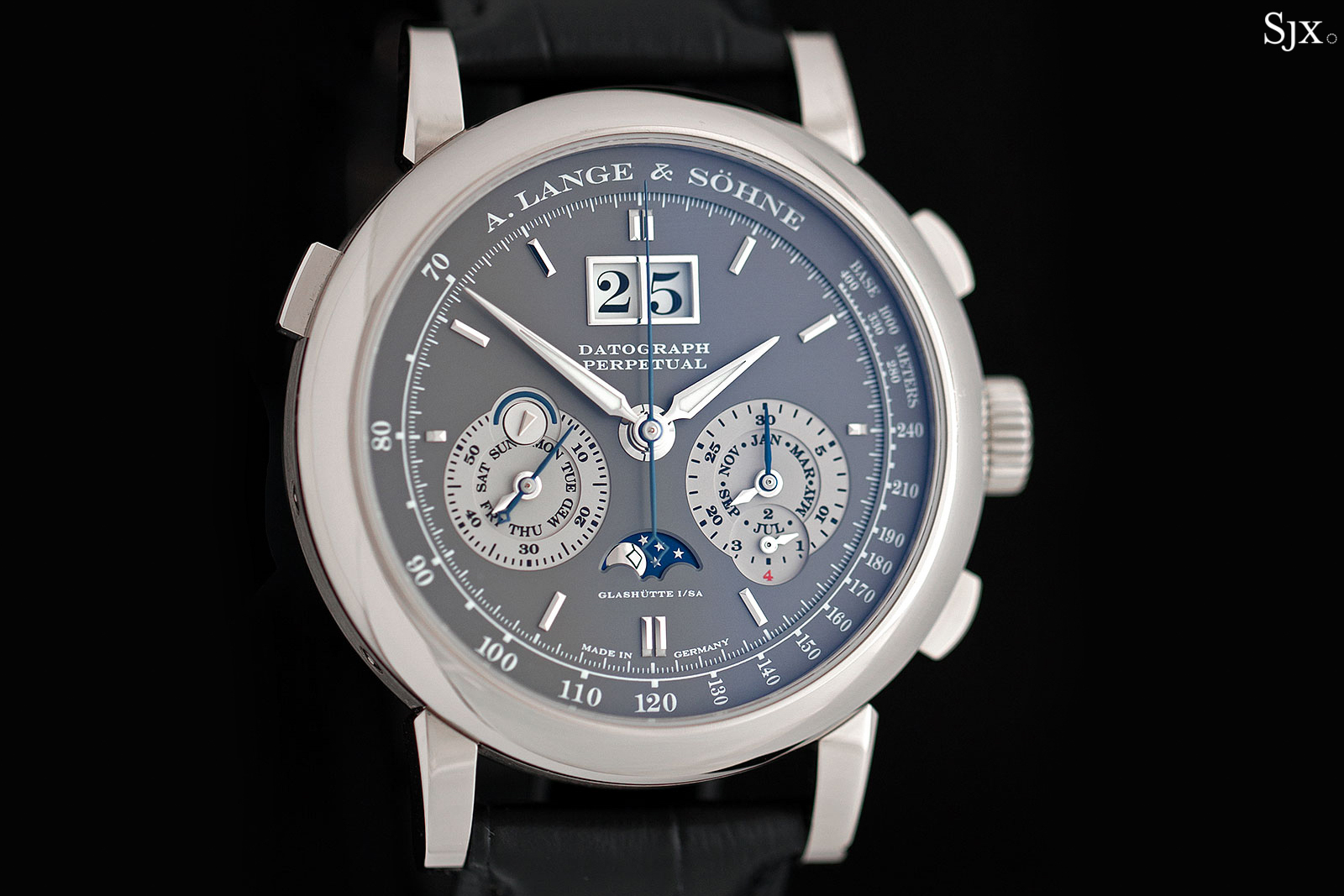
The Datograph Perpetual that has a cluster of additional sub-dials for the day/night and leap year indicators
The first version of the Datograph Perpetual Tourbillon featured a black dial with matching black date discs.
In contrast, the rose gold dial is fitted with the white date discs that are the convention for most Lange watches. Of course, this is driven by the instantaneous perpetual calendar mechanism, with the date digits crisply jumping at midnight.
For months with less than 31 days, the big date immediately skips digits and goes to the 1st of the following month.
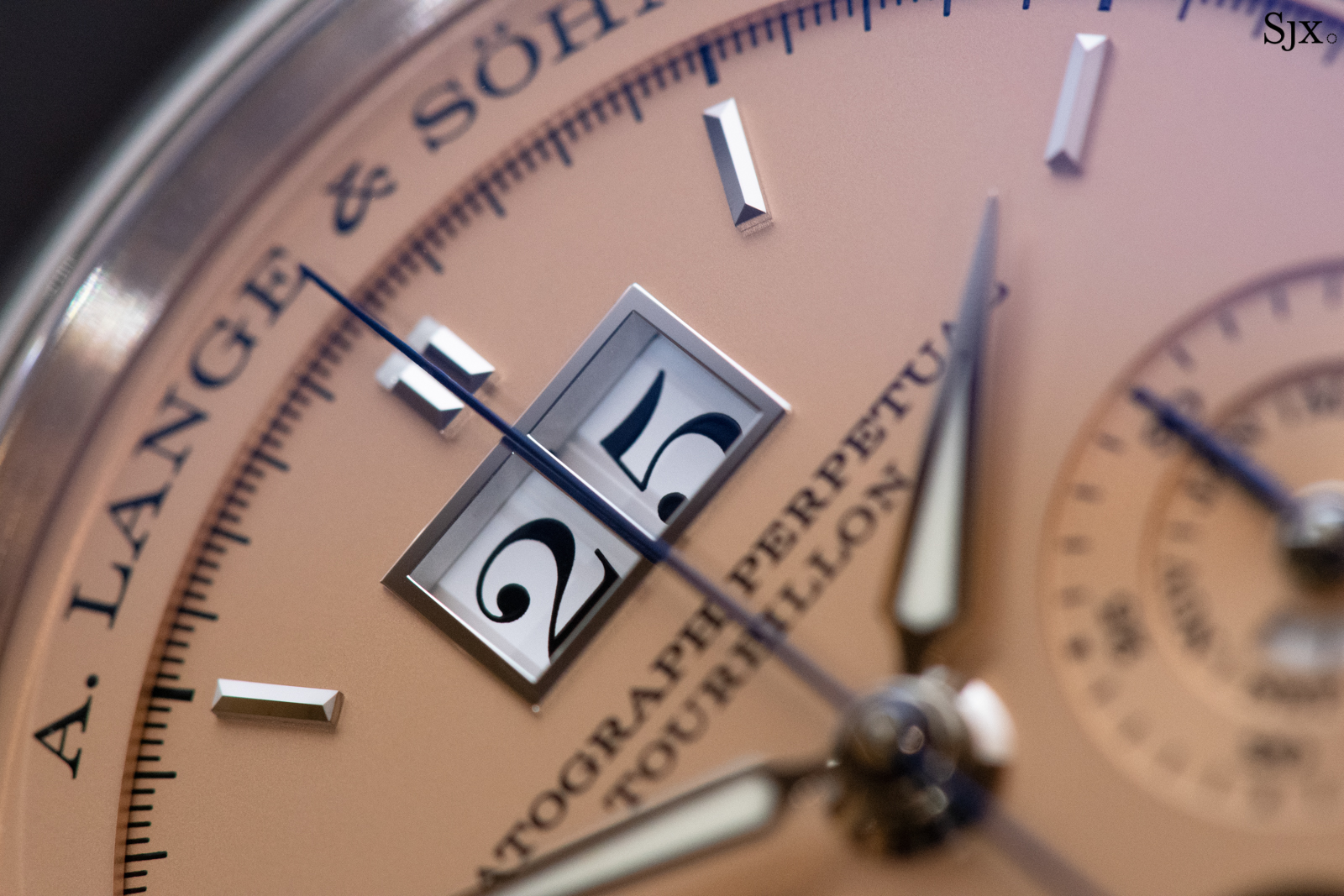
White date discs, a signature Lange design element modelled on the clock inside Dresden’s Semper Opera
One of the cleverest indicators on the dial is the discreet linear power reserve at 10 o’clock that sits on the raised tachymeter ring.
It uses a bi-coloured scale, with more red showing as the mainspring unwinds; once the barrel is empty the scale is entirely red. This is a sensible display that reduces the clutter of the rest of the dial significantly, since conventional, fan-shaped power reserve indicators tend to take up significant real estate.
As with all Datographs, the hour markers at the quarters have “lumed” tips. Together with the luminous hour and minute hands, this allows for minimal legibility in the dark. If low-light legibility is truly a concern, the recent Datograph Up/Down Lumen may be the answer, although all 200 pieces have already been spoken for.
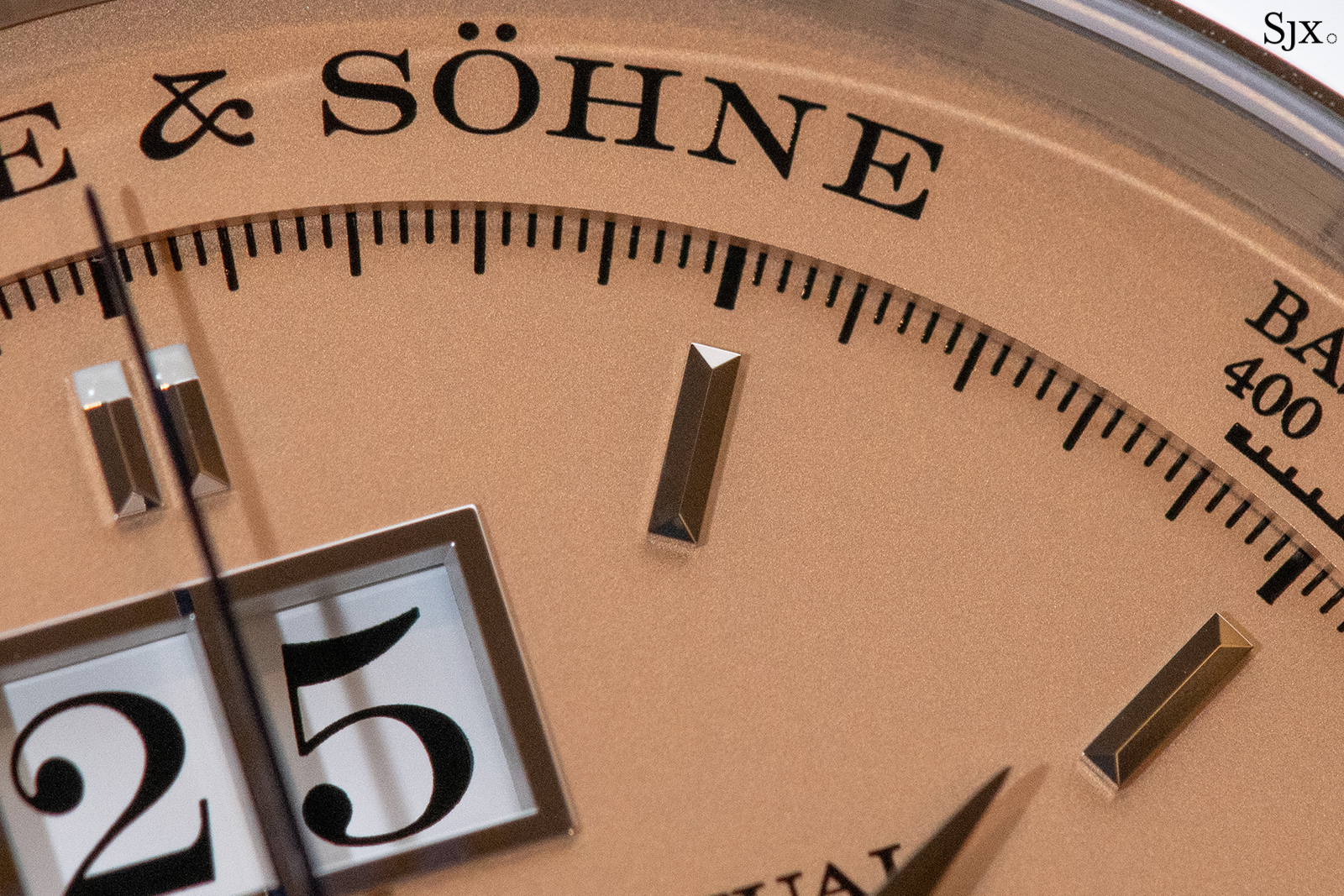
The raised tachymeter ring bearing the brand’s logo at 12 o’clock, and just below that the “lumed” double batons for the hour markers
Nerdy nitpicking
On the subject of the raised tachymeter ring, a technical criticism is due.
It was a missed opportunity not to have the chronograph seconds hashmarks on the raised tachymeter ring – as is done on the second generation 1815 Chronographs – instead of on the outer edge of the dial.
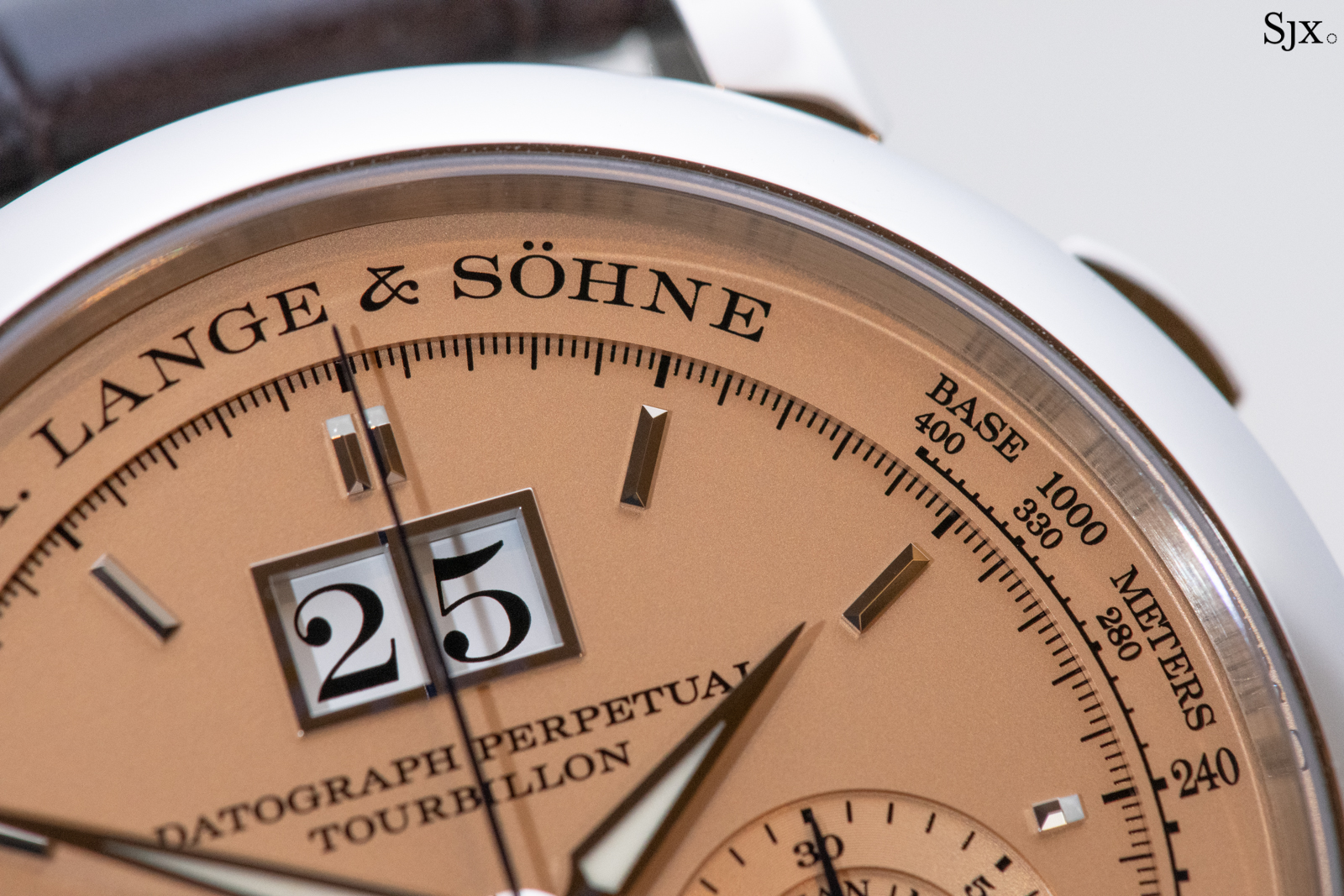
Putting the hashmarks on the tachymeter ring would have reduced the distance between the chronograph seconds hand to the dial – that’s because the ring is raised above the dial – thus reducing parallax error when reading the elapsed seconds.
Of course, such a solution would require additional space by removing or shrinking the tachymetric scale and possibly the power reserve indicator, but is still an acceptable compromise in pursuit of enhanced functionality.
A hefty case
The case comes in at 41.5mm, which is only marginally larger than the Datograph Perpetual despite the addition of a large tourbillon regulator. In fact, the addition of a perpetual calendar to the original Datograph didn’t affect the diameter much since the movement under the dial already had plenty of empty space to begin with.
Though not wider, the movement is higher, as its parts are stacked vertically. With an instantaneous perpetual calendar and a tourbillon, the result is a thick watch – 14.6mm high at that, with the movement taking up of 9mm the total height.
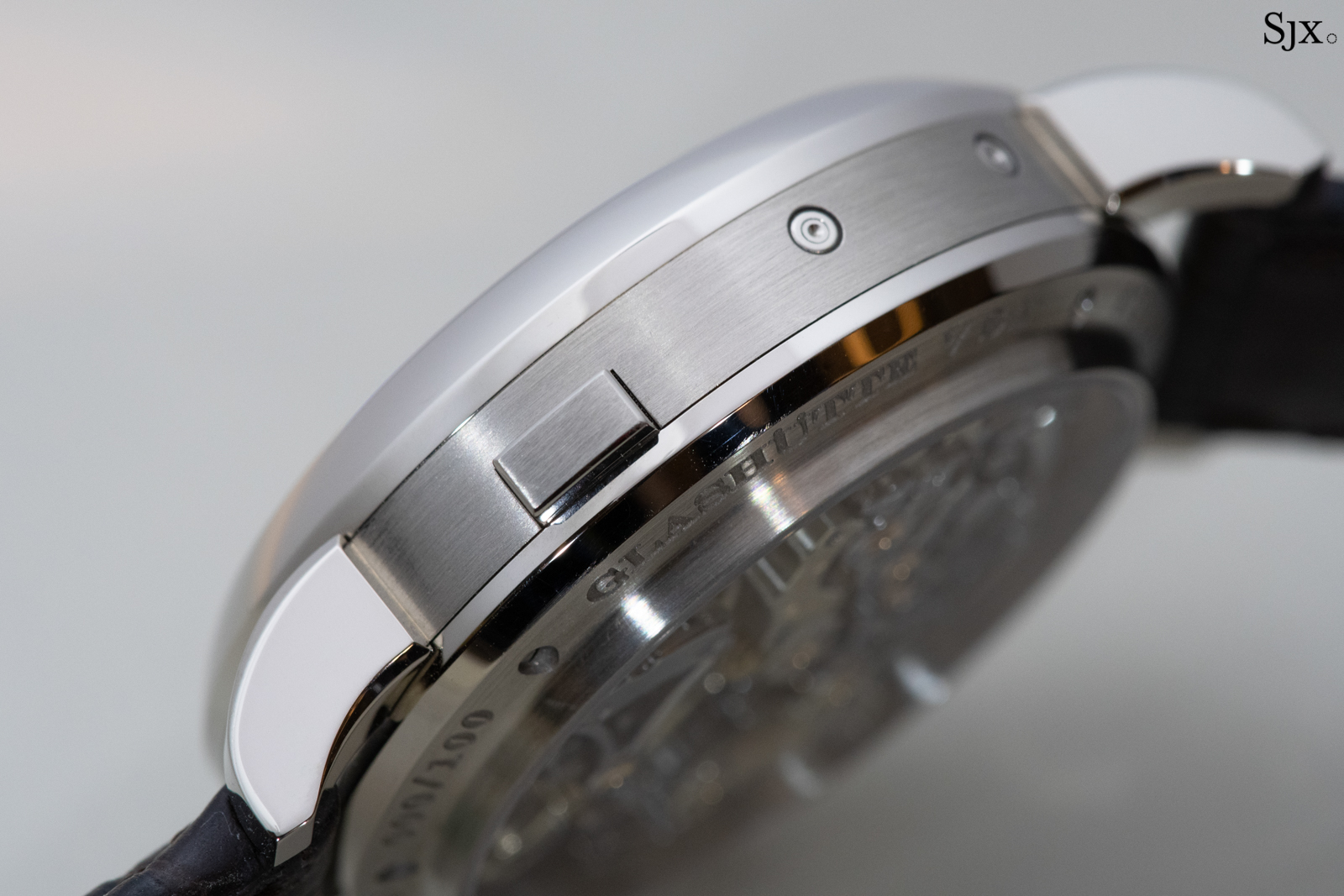
The case has the main pusher at 11 o’clock for advancing all the calendar functions simultaneously, along with recessed pushers are for manually adjusting the individual calendar displays
As with most other thick Lange watches, this is alleviated slightly by a raised flange on the case back to accommodate the movement, and to give the impression of a thinner case middle.
Another visual trick used to disguise the thickness is the brushed mid-section of the case that helps to break up the visual verticality of the case while also providing some contrast between the bezel, middle and back.
While the first version of the Datograph Perpetual Tourbillon was case in platinum, this version is in 18k white gold. This makes it tangibly lighter, but is still comically heavy as an everyday watch, as is often the case for multi-complication Lange watches – which are naturally never available in steel or titanium.
An insight into the mechanics
Unsurprisingly, the highlight of the watch can be seen in all its glory through the display back – the L952.2 that boasts a massive, 729-part count. Combining the chronograph mechanism of the Datograph Perpetual with a generously sized tourbillon, the movement is a significant accomplishment.
While it is easy to dismiss the movement being simply that – a stack of old school complication – it is a sensible approach to the design of such a movement, with few other alternatives, excepting of course, building a new chronograph tourbillon movement from scratch (which would then no longer be descended from the Datograph).
Big balance, small balance
What were the limitations in constructing the L952.2 with additional complications?
To start with, the original Datograph beats at a leisurely 2.5hz, which necessitates a large balance wheel. To contain this within a tourbillon cage requires even more space and thus, the overall movement diameter has to be increased.
Meanwhile, the goal of reconstructing the movement was to preserve the existing chronograph mechanisms while adding other complications, which results in a little gap along the periphery of the larger movement plate. This, unfortunately, makes the case appear a little too big for the movement – at least, compared to the back used for the original Datograph.
Conversely, the larger movement diameter has an upside: space for the linear power reserve indicator that sits on the edge of the dial.
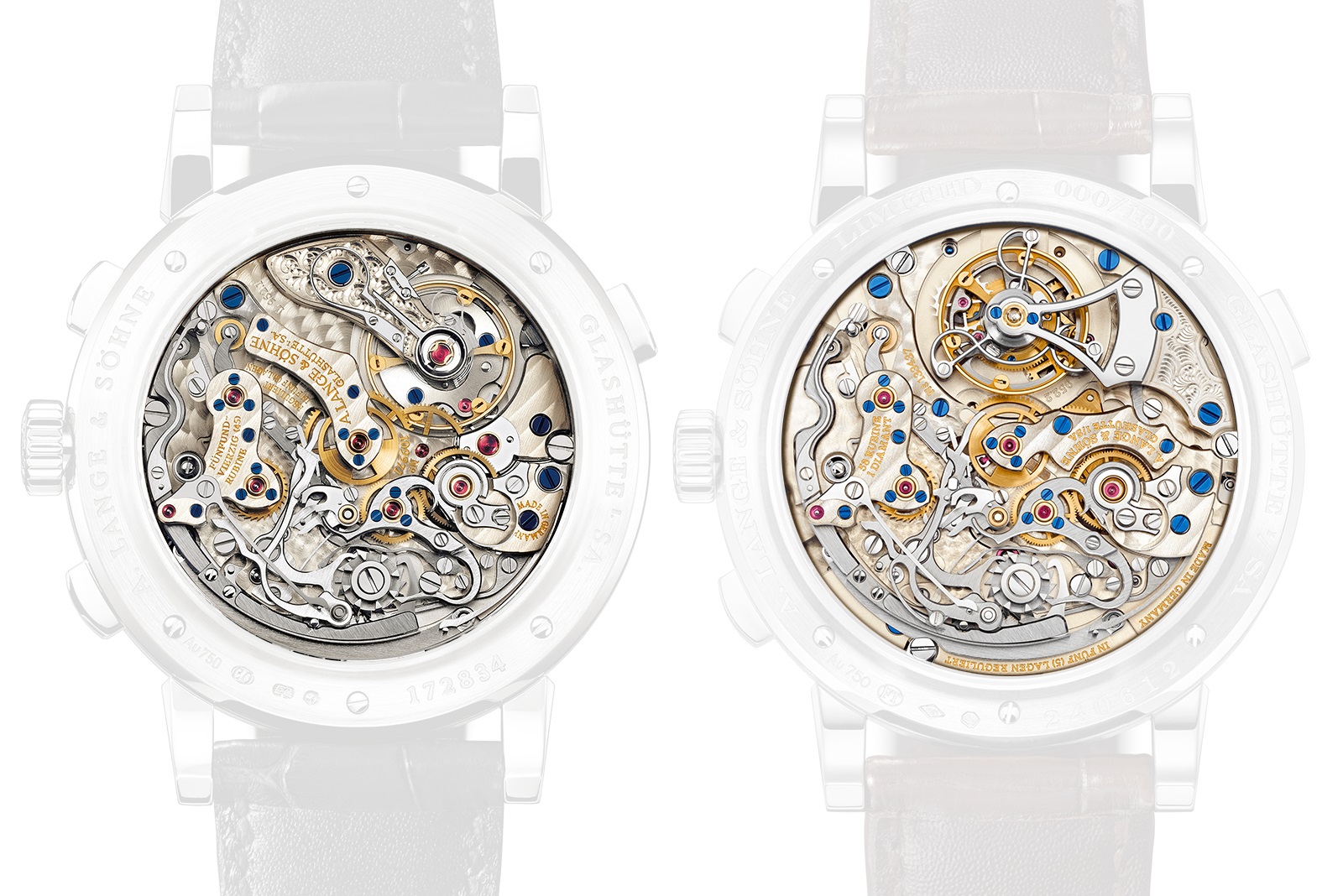
The Datograph Perpetual (left) and Datograph Perpetual Tourbillon – notice the extra space around the periphery of latter’s chronograph movement. Photo – A. Lange & Söhne
Would a smaller balance wheel have made it smaller?
True, a smaller balance wheel, and hence smaller cage, might have fit into the existing layout without increasing the movement diameter. However, a smaller balance wheel can oscillate at a higher frequency – maintaining the original 2.5Hz beat conveniently allows the existing chronograph parts to be reused. But if the movement ran at a higher frequency, such as 4Hz, chronograph parts like the jumping minutes counter might have to be redesigned to accommodate tighter tolerances.
Also, 2.5Hz is the classical ideal for a chronograph, as it allows measurements with a resolution of up to 0.2 seconds, a round decimal number. In contrast, a 3Hz movement measures intervals of 0.167s, while 4Hz measures 0.125s – “three-sixths of a second” isn’t convenient to record.
And ultimately, a larger tourbillon cage has more visual appeal; it animatedly completes a revolution every 60 seconds.
The familiar chronograph
Since the chronograph mechanism itself is mostly untouched, many of the parts are virtually identical to the L951.6 of the Datograph Up/Down.
This includes all the refinements over the first generation Datograph – most prominently, a curved buffer spring has been incorporated into the reset lever to ensure a smoother and safer reset mechanism.
Other refinements include a hacking lever for the tourbillon cage – just barely visible on the lower left of the balance wheel in the above image – which allows precise setting of the time.
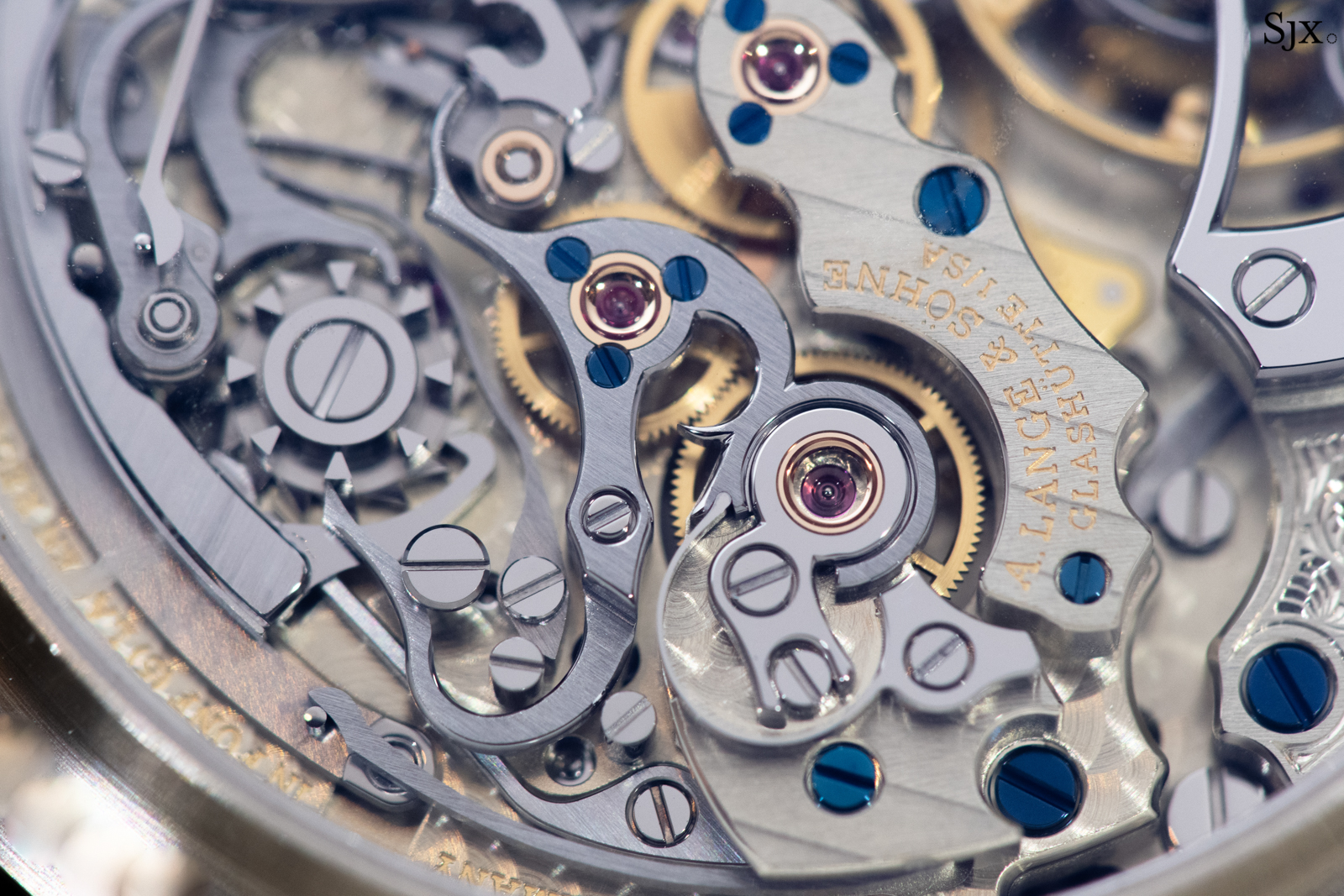
The signature lateral clutch and column wheel; next to it is the redesigned chronograph bridge to accommodate the tourbillon cock
Lange finishing
The visible movement parts are all finished in typical Lange manner – in other words, to exemplary standards.
Since this is a chronograph, there is an abundance of moving levers that finished with a linear brushing. This contrasts with the black polished stationary steel parts.
Most noteworthy – and praiseworthy – is the sharp, inward anglage visible on the tourbillon cock and lateral clutch, evidence of true hand finishing.
Last but not least, as with any Lange tourbillon, the base of the tourbillon cock is hand-engraved with a floral motif.
Overall, the visible chronograph movement is not groundbreaking, but that’s for the best – it is familiar enough to be pleasing to the eyes.
As words can only describe so much, it is best to appreciate the moving components in action; illustrated by the following two videos.
The first shows the rotating tourbillon cage and jumping minute counter of the chronograph, while the second captures the operation of the chronograph, showcasing the start, flyback reset and stop functions.
A walk down perpetual lane
While the back is familiar, there is arguably more new developments on the other side of the movement, hidden beneath the dial.
Under the “salmon” dial lies a brand new perpetual calendar mechanism that instantaneously jumps at midnight. It is an evolution of the previous, non-instantaneous calendar in the Datograph Perpetual, which was in turn inspired by the L922.1 of the Langematik Perpetual, the brand’s first perpetual calendar.
To best appreciate the new calendar mechanism, it is worth looking into its predecessors for comparison.
It began in 2001 with the release of the Cal L922.1, a traditional perpetual calendar that is paired with Lange’s big date display. The heart of the perpetual calendar, the grand levier, can be seen spanning across the top of the movement at 12 o’clock. Meanwhile, the program wheel – a disc with 48 notches that keeps track of short and long months – is situated at 4 o’clock.
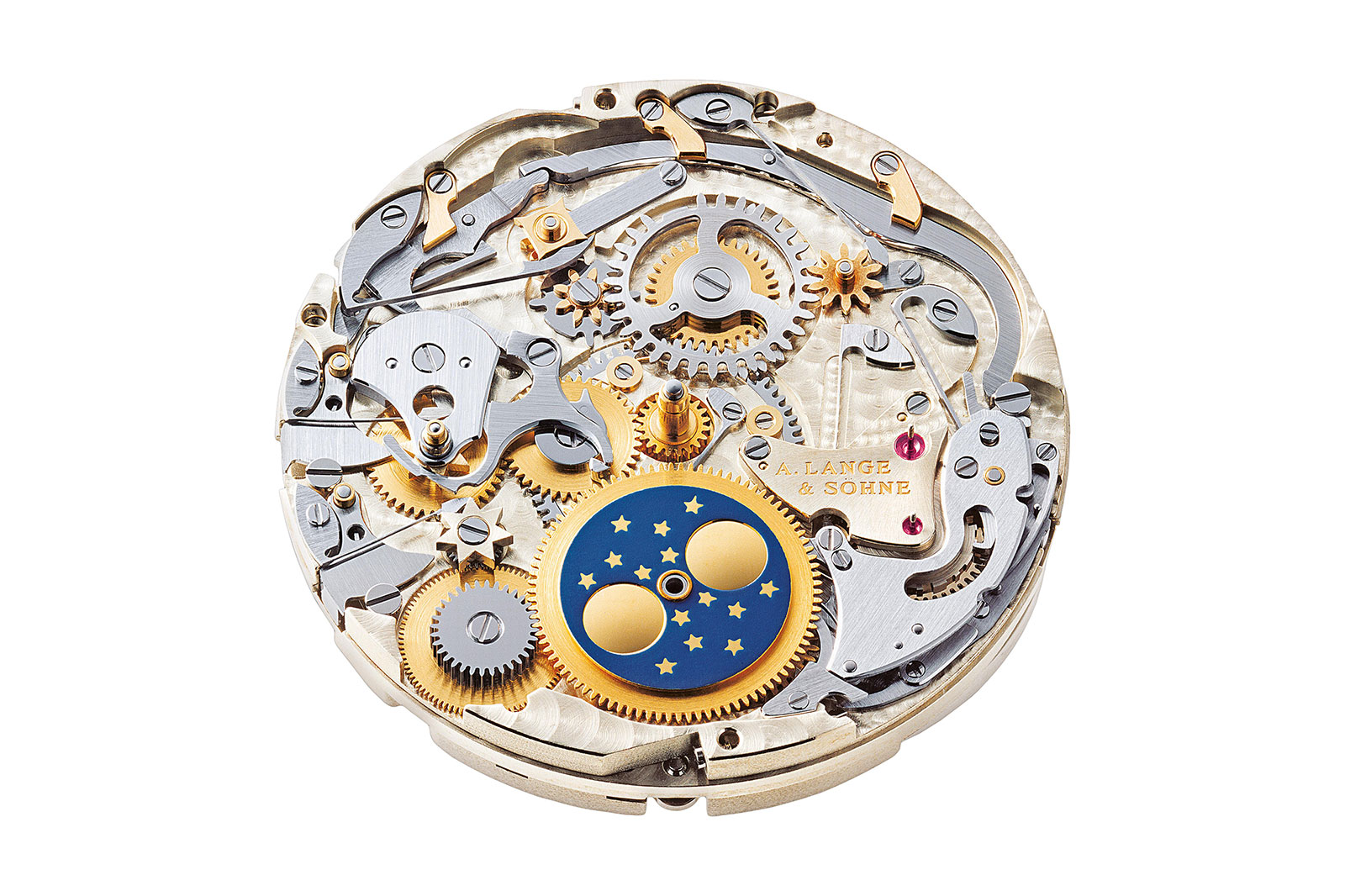
The Cal L922.1, Lange’s first Perpetual Calendar, and the first movement to combine a perpetual calendar with a big date. Photo – A. Lange & Söhne
Five years later, this was refined with the L952.1 in the Datograph Perpetual. On the surface, it uses the same basic layout for the calendar.
However, it is mechanically different as it now has a shorter grand levier – the big lever that underpins the calendar – that runs underneath the moon phase disc instead of acres the movement. This occupies less space, and theoretically reduces the tolerances needed for correct functioning versus the longer lever used in the L922.1.
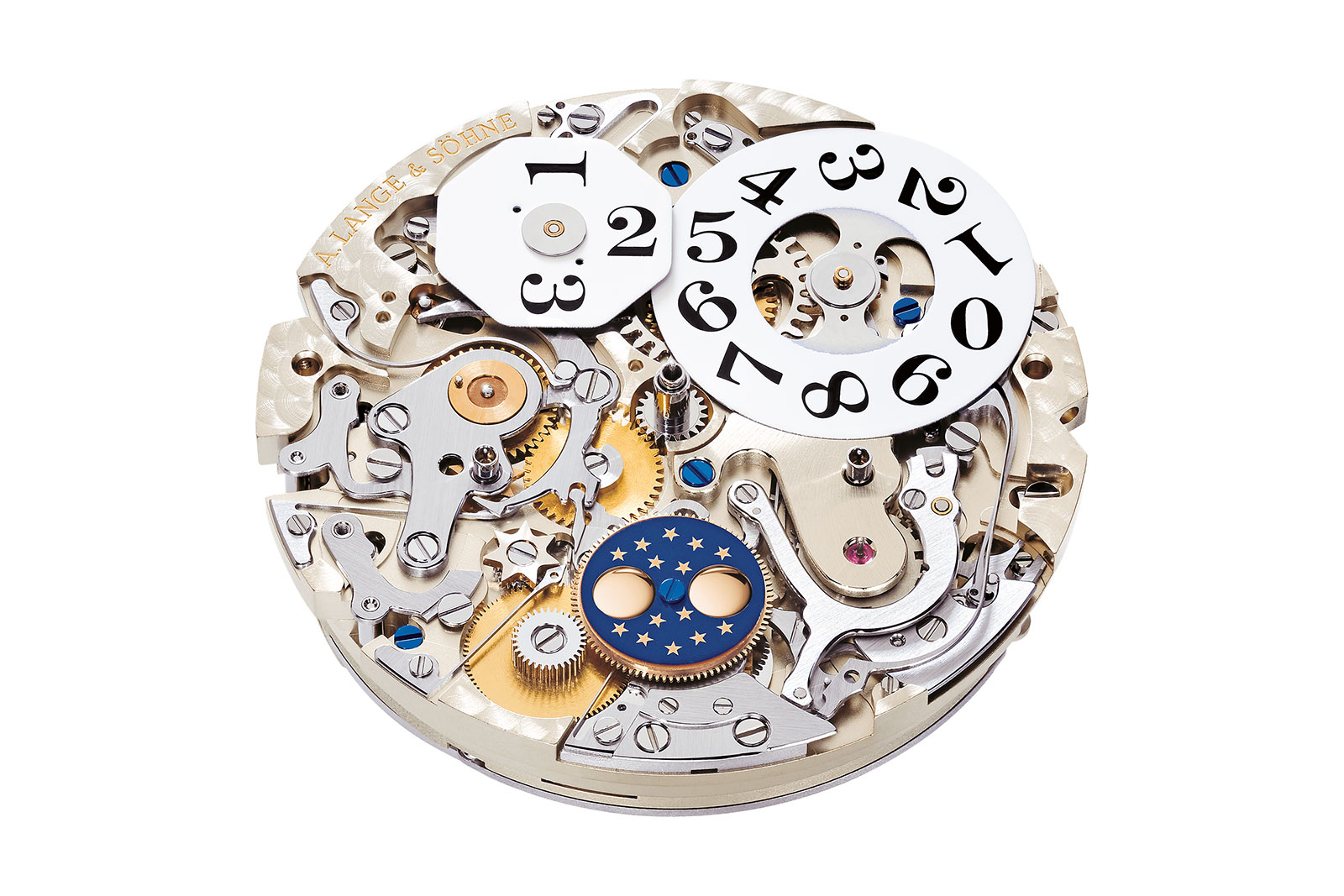
The Cal L952.1 of the Datograph Perpetual. Photo – A. Lange & Söhne
The L952.1 also has a useful trick up its sleeve – a safety mechanism for the calendar corrector. The Datograph Perpetual has a large pusher at 10 o’clock – mimicking the date pusher of the original Datograph – that simultaneously advances all the calendar indicators a day at a time.
That also explains why the top of the line calendar watches are sold with a folding clasp instead of a regular pin buckle. It’s dictated by the logic that that when not on the wrist, the watch will sit on its side, which may accidentally trigger the pusher.
Thus, a system was devised such that the pusher can only be used when the crown is pulled out one stop. When the crown is pulled, it retracts a sliding lever, allowing the pusher to be depressed.
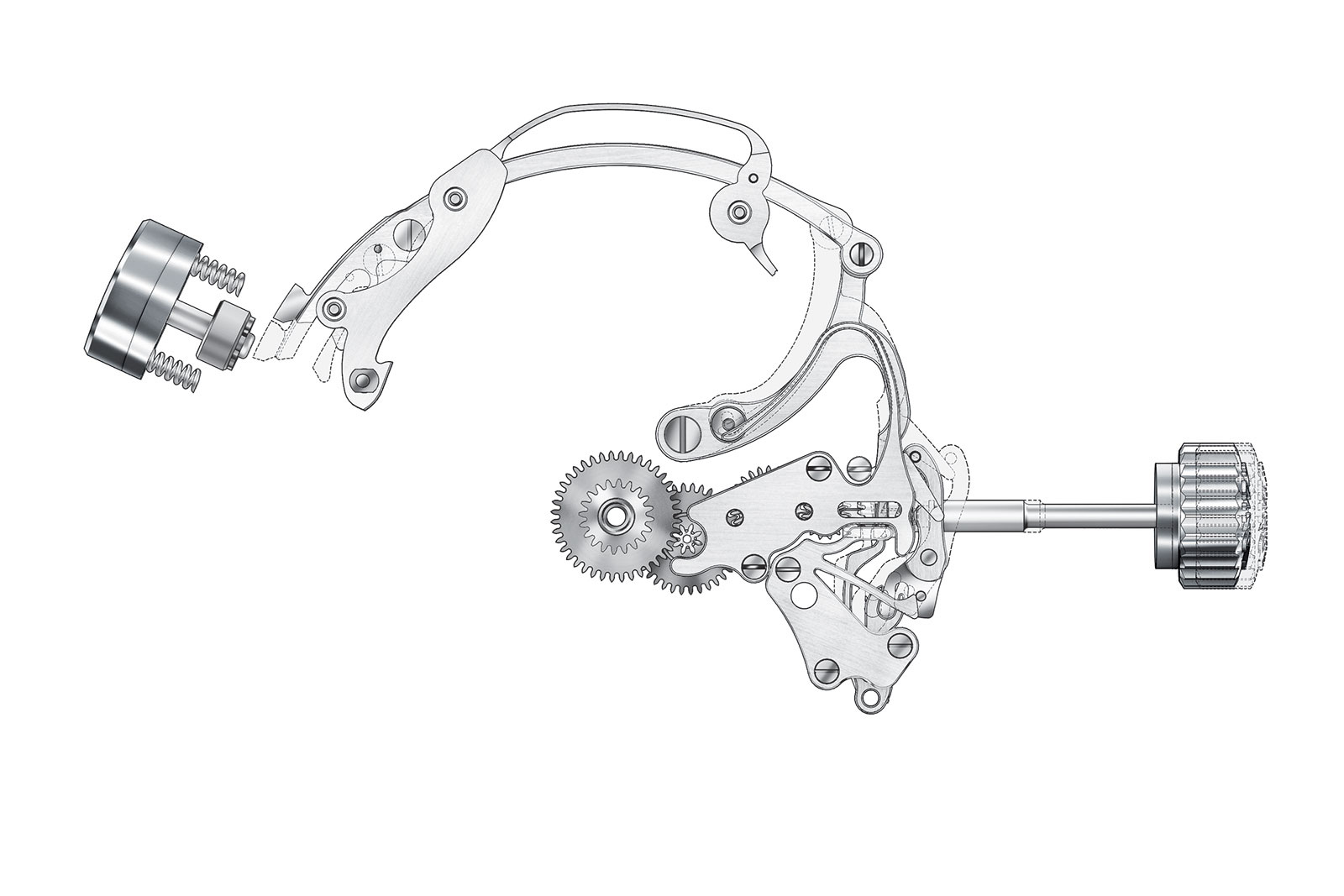
The safety mechanism of the calendar pusher, disengaged via the crown. Diagram – A. Lange & Söhne
Under the “salmon” dial
All these innovations have been kept in L952.2 of the Datograph Perpetual Tourbillon. While it preserves the layout of the original Datograph Perpetual, all the levers have been redesigned to accomplish an additional feature – the instantaneous perpetual calendar.
Unlike a regular perpetual with a “dragging” display that changes gradually around midnight, an instantaneous perpetual calendar requires more energy to operate.
This is because energy is stored up in a spring over 24 hours, which is then released at midnight to advance all the calendar indications simultaneously in an instant. Consequently, the large impulse of released energy requires thicker levers and wheels for durability.
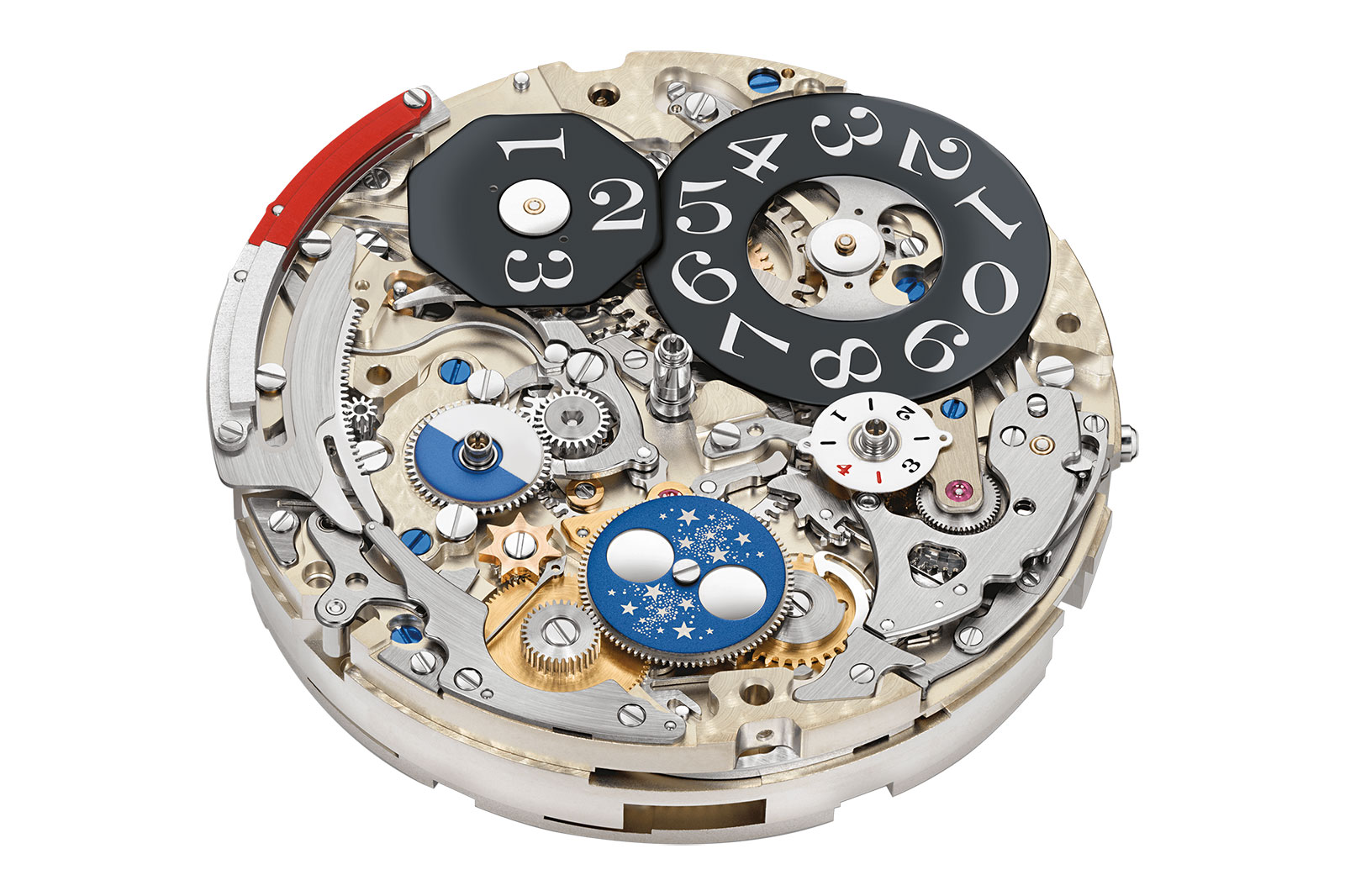
The L952.2 of the Datograph Perpetual Tourbillon. Photo – A. Lange & Söhne
The inclusion of a tourbillon also means that the gear train has to be redesigned, which also further adds to the movement thickness of 9mm. Overall, this leads to an unapologetically thick watch, which is something that Lange isn’t shy to do.
Given the additional complications, the Datograph Perpetual Tourbillon still has a decent power reserve of 50 hours – just ten hours less than the standard Datograph Up/Down.
Closing thoughts
As an iteration of an existing model, the new Datograph Perpetual Tourbillon has less of an impact compared to to the unveiling of the original in 2016.
It is also questionable if the idea of a rose gold dial is a response to current trends, or if it’s an honest, deliberate design choice.
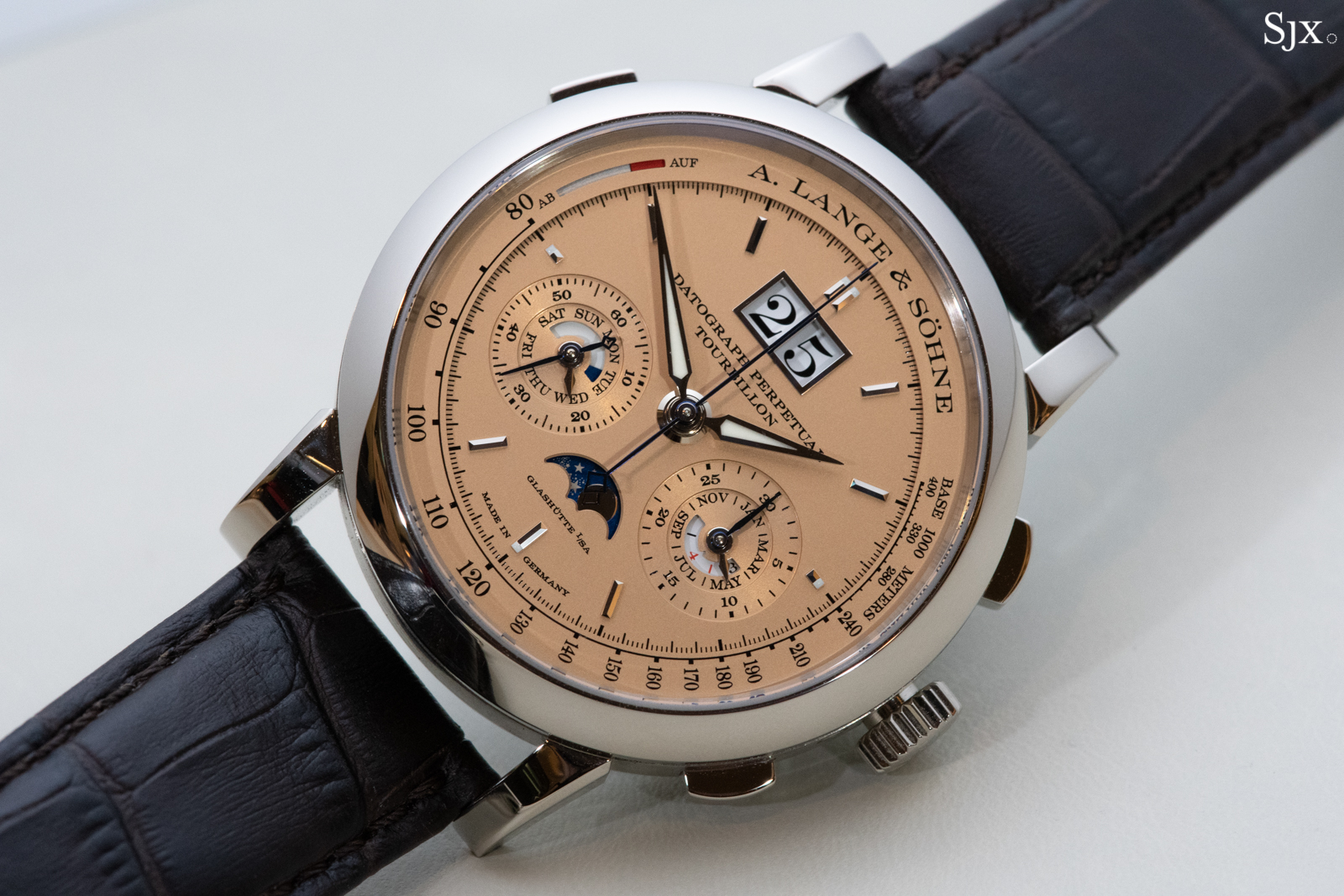
Either way, it is still a strong statement of a watch. It may not be the most revolutionary piece – more towards an agglomeration of existing ideas – however, everything is executed beautifully while retaining an overall design ethos that is unmistakably Lange.
Given the complexity of the perpetual calendar mechanism that goes unseen, it is wishful thinking but perhaps one day a Datograph Perpetual Lumen would showcase the wonders under dial. (Dear Messrs Schmid and de Haas, I hope you are reading this.)
Key facts
Diameter: 41.5mm
Thickness: 14.6mm
Material: 18k white gold
Water-resistance: 30m
Movement: L952.2
Functions: Time, chronograph, perpetual calendar with big date and moon phase
Winding: Hand-wound
Frequency: 18,000 beats per hour, or 2.5Hz
Power reserve: 50 hours
Pricing and Availability
The Datograph Perpetual Tourbillon with a pink gold dial (ref. 740.056) is limited to 100 watches, priced at US$287,800, or 399,500 Singapore dollars.
Correction Aug 8, 2019: Added a note about a smaller balance wheel running faster.
Back to top.
